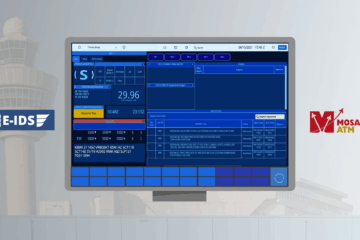In January 2025, Mosaic ATM conducted a flight trial of a novel method of managing aircraft using a rule-based system to sequence and space aircraft arriving at a common waypoint—without using centralized control. The idea is part of a larger NASA-sponsored project involving Digital Flight. Digital Flight is a forward-looking concept being investigated in NASA’s Transformative Aeronautics Concepts Program. It envisions a future where aviation systems are digitally integrated, highly automated, and interoperable across airspace, operators, service providers, and use cases. The goal is to revolutionize how flights are planned, executed, and managed, using digital technologies to increase efficiency, safety, and environmental performance.
The live flight test conducted by Mosaic ATM demonstrated a key concept of Digital Flight called rule-based aircraft sequencing, where a simple set of rules that are independently and simultaneously executed by different flights sharing a common waypoint is determined to be sufficient to self-organize in their approach to the waypoint. The set of rules was developed by NASA’s Digital Flight team in conjunction with Mosaic ATM researchers and first tested in a fast-time simulation and a Hardware-in-the-Loop environment before being flight tested in airspace north of Burlington, Vermont in January.
The test consisted of one live aircraft flown by AdvAero Ltd., two virtual aircraft managed by a Mosaic engineer, and the Cloud Flight Management System (CFMS) that ran the rule base for each flight. CFMS, separately developed by Mosaic through NASA sponsorship over many years, contains a digital twin of each aircraft’s Flight Management System. Each aircraft is connected to a separate CFMS instance, and the CFMS instances communicate with each other through secure internet protocol connections. Each CFMS communicated with its “ownship” through an air-to-ground communications platform, in this case provided by the GoGo network.

The Mosaic-led team that conducted the live flight test north of Burlington, VT in January 2025. From left, Andy Lacher (NASA), Kerry Doherty (AdvAero), John Maris (AdvAero Pilot in Command), Paul Vajda (AdvAero co-pilot), Fred Wieland (Mosaic ATM Principal Investigator), Matt Grochowalski (GE Aviation Systems), David Wing (NASA), and Puthy Soupin (AdvAero).
The rule based aircraft sequencing test consisted of three passes of the live and virtual flights from their starting waypoints (different for each flight) to a common coordination waypoint. An extensive set of metrics gathered through telemetry allowed the team to assess the effectiveness of the rule set to safely coordinate and sequence aircraft through the common waypoint. Of the three passes, the first one had inadequate air-ground communication, while the second and third provided valuable data.


